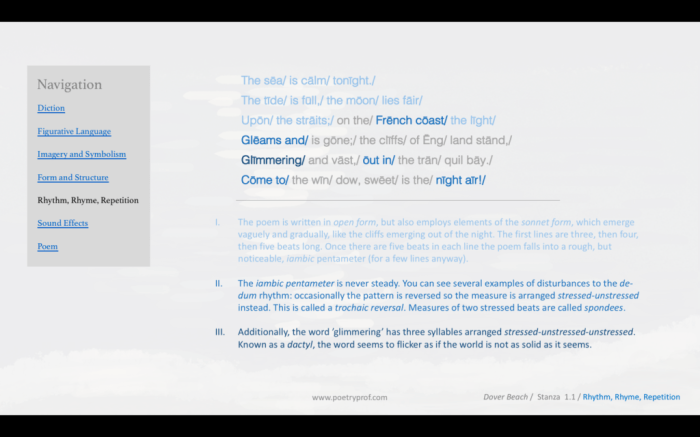Dover Beach figures of speech take center stage in this captivating exploration, inviting readers to delve into a world of literary artistry. From metaphors to personification, each figure of speech employed by the poet paints a vivid tapestry, enhancing the poem’s emotional impact and conveying profound insights.
This comprehensive analysis will unravel the intricate web of figures of speech in “Dover Beach,” examining their types, functions, and contributions to the poem’s overall meaning and atmosphere.
Figures of Speech in “Dover Beach”

Matthew Arnold’s “Dover Beach” is renowned for its evocative imagery and profound meditation on themes of faith, doubt, and the human condition. The poem is replete with a rich tapestry of figures of speech that enhance its emotional impact and deepen its meaning.
One of the most striking features of “Dover Beach” is its use of metaphor. Metaphors create implicit comparisons between two unlike things, revealing hidden similarities and connections. In the poem, Arnold compares the sea to a “darkling plain” and the human condition to a “melancholy, long, withdrawing roar.”
These metaphors evoke a sense of vastness, isolation, and the inexorable passage of time.
Similes, another type of figurative language, are also prevalent in “Dover Beach.” Similes use the words “like” or “as” to make explicit comparisons between two things. Arnold compares the sound of the waves to “the grating roar of pebbles” and the retreating tide to “a lover’s whisper.”
Dover Beach’s evocative imagery and symbolism create a haunting atmosphere, exploring themes of isolation, faith, and the fragility of human existence. While the poem’s figures of speech contribute to its poignant impact, you can delve deeper into the complexities of human nature and the interplay of light and darkness by exploring the ministers black veil pdf . Returning to Dover Beach, its use of metaphors, similes, and personification further enhances its emotional resonance, leaving readers with a profound sense of both wonder and melancholy.
These similes bring the reader closer to the sensory experience of the poem and create a vivid impression of the scene.
Personification, the attribution of human qualities to non-human things, is another important figure of speech in “Dover Beach.” Arnold personifies the sea as a “tremulous cadence” that “beats, beats, beats” against the shore. This personification animates the natural world and suggests a sense of rhythm and purpose in the midst of chaos.
Finally, “Dover Beach” makes effective use of alliteration, the repetition of consonant sounds in close proximity. Arnold’s use of alliteration, such as “darkling plain” and “melancholy, long, withdrawing roar,” creates a musicality that enhances the poem’s emotional impact and makes it more memorable.
The combination of these figures of speech in “Dover Beach” creates a multi-layered and evocative poem that explores the complexities of human experience. Arnold’s skillful use of figurative language allows him to convey profound emotions and ideas in a way that is both accessible and deeply resonant.
Metaphor and Simile in “Dover Beach”

In “Dover Beach,” Matthew Arnold employs metaphors and similes to craft vivid imagery and convey the speaker’s emotions. These figures of speech allow the reader to experience the poem’s themes of isolation, loss of faith, and the search for meaning.
Metaphors
- The sea as a symbol of life’s uncertainty and chaos:“The sea is calm tonight… / But the tide is full, and the moon is bright.” The sea’s calm surface belies the underlying currents and tides, representing the unpredictable nature of life.
- The cliffs as a barrier between the speaker and the sea:“The cliffs of England stand, / Glimmering and vast, out in the tranquil bay.” The cliffs symbolize the speaker’s isolation and inability to connect with the outside world.
- The lighthouse as a beacon of hope:“The lighthouse is a dusky tower… / Burning in the night.” The lighthouse represents the speaker’s longing for guidance and meaning in the face of darkness.
Similes
- The speaker’s voice compared to a wave:“Listen! you hear the grating roar / Of pebbles which the waves draw back, and fling, / At their return, up the high strand.” The wave’s relentless motion suggests the speaker’s own struggle against the forces of life.
- The speaker’s sadness compared to a tide:“The world, which seems to lie before us like a land of dreams, / So various, so beautiful, so new, / Hath really neither joy, nor love, nor light, / Nor certitude, nor peace, nor help for pain; / And we are here as on a darkling plain / Swept with confused alarms of struggle and flight, / Where ignorant armies clash by night.”
The tide’s constant ebb and flow symbolize the speaker’s fluctuating emotions and sense of despair.
Symbolism in “Dover Beach”

Matthew Arnold’s “Dover Beach” employs various symbols that contribute to its profound exploration of faith, doubt, and the human condition. These symbols enrich the poem’s meaning, inviting readers to contemplate the abstract ideas they represent.
The Sea
The vast and ever-changing sea serves as a metaphor for the relentless passage of time and the transience of human existence. Its “melancholy, long, withdrawing roar” echoes the speaker’s sense of loss and longing as he reflects on the fading faith of his generation.
The Cliffs
The towering cliffs represent the barriers that separate individuals from a meaningful connection with the divine. Their “iron bars” symbolize the obstacles to faith and the isolation that results from doubt.
The Lighthouse
The lighthouse, with its “tremulous beam,” stands as a beacon of hope amidst the darkness of uncertainty. It represents the speaker’s longing for a guiding light in a world where faith seems to be dwindling.
Personification in “Dover Beach”

Personification is a figure of speech that gives human qualities to non-human things. In “Dover Beach,” Matthew Arnold uses personification to enhance the emotional impact of the poem and to convey the speaker’s feelings of isolation and despair.
Instances of Personification
- “The sea is calm tonight”
- “The cliffs of England stand/Glimmering and vast”
- “The Dover Beach is listening”
- “The world is too much with us”
- “The night is creeping up on me”
By giving human qualities to the sea, the cliffs, and the night, Arnold creates a sense of intimacy and connection between the speaker and the natural world. This connection allows the speaker to express his emotions more openly and directly.
Emotional Impact
The use of personification in “Dover Beach” enhances the emotional impact of the poem by making the speaker’s feelings more relatable and tangible. By giving human qualities to the non-human things in the poem, Arnold creates a sense of empathy between the reader and the speaker.
For example, the personification of the sea as “calm” and “listening” suggests that the speaker finds solace in the natural world. However, the personification of the night as “creeping up” on the speaker suggests a sense of foreboding and anxiety.
Through the use of personification, Arnold is able to convey the speaker’s complex and conflicting emotions in a way that is both powerful and moving.
Imagery and Sensory Details in “Dover Beach”
Matthew Arnold’s “Dover Beach” is a poem that vividly captures the sense of isolation and loss that was prevalent in Victorian England. The poem’s use of sensory details engages the reader’s senses and creates a vivid atmosphere that reflects the speaker’s emotional state.
One of the most striking images in the poem is that of the “sea of faith” that has “retreated” and left behind only “naked shingles.” This image suggests a loss of religious belief and the accompanying sense of meaninglessness and despair.
The “naked shingles” are a stark reminder of the harsh reality that remains when faith is gone.
Another powerful image in the poem is that of the “eternal note of sadness” that the speaker hears in the waves. This image suggests that the sense of loss and isolation is not just a personal experience but a universal one.
The waves are a symbol of the relentless passage of time and the inevitability of death.
The use of sensory details in “Dover Beach” helps to create a vivid and immersive experience for the reader. The poem’s imagery appeals to the senses of sight, sound, and touch, creating a sense of immediacy and authenticity. The reader can feel the cold wind on their face, hear the waves crashing on the shore, and see the “naked shingles” that are left behind by the receding sea.
Auditory Imagery
- The “eternal note of sadness” that the speaker hears in the waves creates a sense of melancholy and loss.
- The “sound of the sea” is described as “mournful” and “monotonous,” reinforcing the sense of isolation and despair.
Visual Imagery
- The “sea of faith” that has “retreated” and left behind only “naked shingles” is a powerful image of loss and despair.
- The “darkling plain” and the “ignorant armies” suggest a sense of chaos and confusion.
Tactile Imagery
- The “cold” wind on the speaker’s face suggests a sense of isolation and loneliness.
- The “naked shingles” are described as “sharp” and “cold,” reinforcing the sense of harsh reality.
The use of sensory details in “Dover Beach” helps to create a vivid and immersive experience for the reader. The poem’s imagery appeals to the senses of sight, sound, and touch, creating a sense of immediacy and authenticity. The reader can feel the cold wind on their face, hear the waves crashing on the shore, and see the “naked shingles” that are left behind by the receding sea.
Sound Devices in “Dover Beach”: Dover Beach Figures Of Speech
Matthew Arnold’s “Dover Beach” employs a rich tapestry of sound devices to create a musical and emotionally resonant experience. These devices enhance the poem’s atmosphere and convey its themes of isolation, doubt, and longing.
Alliteration
- “So far, so fast the tides of human race”: The repetition of the “s” sound creates a sense of urgency and the relentless passage of time.
- “Where ignorant armies clash by night”: The alliteration of “ignorant armies” emphasizes the futility and chaos of human conflict.
- “And the world shows like a dream”: The repetition of the “d” sound evokes a sense of disorientation and unreality.
Assonance, Dover beach figures of speech
- “Listen! you hear the grating roar”: The repetition of the “o” sound creates a sense of foreboding and unease.
- “And we are here as on a darkling plain”: The assonance of “darkling” and “plain” contributes to the poem’s atmosphere of gloom and isolation.
- “And the sea shows like a silver snake”: The assonance of “sea” and “snake” suggests a sense of danger and the unknown.
Consonance
- “Of melancholy, long, withdrawing roar”: The repetition of the “r” sound creates a sense of sadness and longing.
- “Retreating, to the breath / Of the night-wind”: The consonance of “retreating” and “breath” reinforces the sense of withdrawal and isolation.
- “To the stars, to the stars”: The repetition of the “s” sound in the final line evokes a sense of longing and aspiration.
Irony and Paradox in “Dover Beach”

Irony and paradox are literary devices that create tension and add depth to the poem’s meaning. In “Dover Beach,” irony is evident in the contrast between the peaceful setting and the speaker’s inner turmoil. The paradox lies in the speaker’s longing for faith in a world that seems devoid of it.
Irony
The poem opens with a serene description of the Dover coastline. The “calm,” “long lines of spray,” and “moonlit sand” suggest a tranquil setting. However, this tranquility is juxtaposed with the speaker’s restless mind, which is filled with “ignorant armies” and “an eternal note of sadness.”
The contrast between the external peace and the speaker’s inner turmoil creates a sense of irony.
Paradox
The poem also contains several paradoxes. For example, the speaker describes the sea as both “Dover’s” and “the world’s,” suggesting that it is both familiar and vast. Similarly, the speaker longs for faith but recognizes that it is “lost.” These paradoxes reflect the speaker’s struggle to reconcile his desire for certainty with the uncertainty of the modern world.
Common Queries
What is the significance of the sea imagery in “Dover Beach”?
The sea in “Dover Beach” symbolizes the vastness and mystery of life, the ebb and flow of human emotions, and the uncertainty of the future.
How does the use of personification contribute to the poem’s emotional impact?
Personification gives human qualities to non-human things, such as the sea and the cliffs, which enhances the emotional connection between the reader and the natural world.
What is the purpose of the irony in the poem’s final stanza?
The irony in the final stanza highlights the contrast between the speaker’s desire for faith and the reality of a world without it, creating a sense of tension and adding depth to the poem’s meaning.